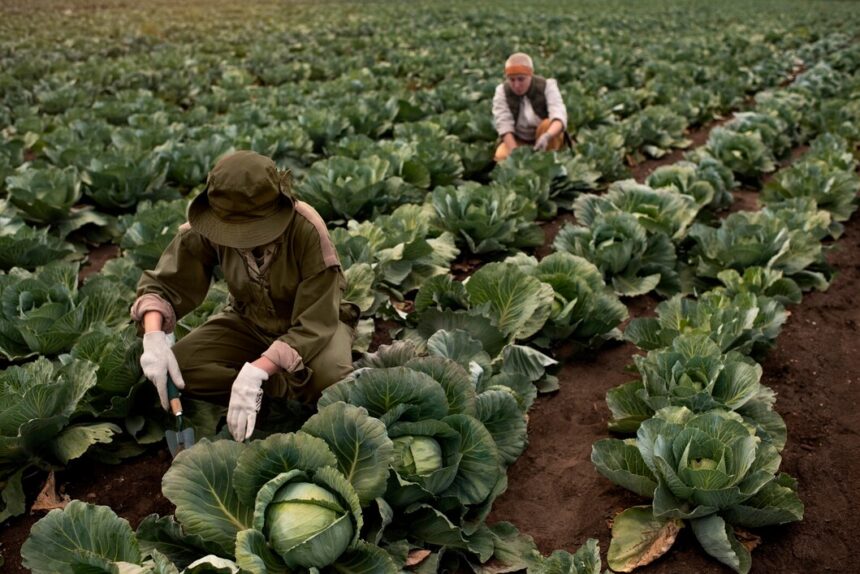Cabbage (Brassica oleracea var. capitata) is a popular vegetable in South Africa, known for its nutritional value and versatility in cooking. Growing cabbage can be a rewarding venture, but it requires careful planning and attention to detail from seed to harvest. This article provides a detailed guide on the entire process of growing cabbage, including land preparation, growth stages, necessary inputs, and pest management.
1. Land Preparation
Soil Type
Cabbage thrives in well-drained, fertile soils with a pH of 6.0 to 6.8. Sandy loam or clay loam soils are ideal, as they provide good drainage while retaining moisture.
Soil Testing
Before planting, conduct a soil test to determine nutrient levels and pH. Amend the soil based on the results, using lime to raise pH or sulfur to lower it if necessary.
Tillage
Prepare the land by plowing to a depth of at least 30 cm, followed by harrowing to break up clumps and create a fine seedbed.
Fertilization
Incorporate well-rotted manure or compost into the soil to improve fertility. A balanced fertilizer high in nitrogen, phosphorus, and potassium (such as 10-10-10) should be applied based on soil test recommendations.
2. Seed Selection and Sowing
Choosing Seeds
Select high-quality cabbage seeds suitable for your local climate. Varieties such as “Korean Cabbage” or “Savoy” are popular in South Africa due to their adaptability.
Sowing
Cabbage can be direct-seeded or started in seed trays. If starting indoors, sow seeds 8-10 weeks before the last frost date. Transplant seedlings when they are 10-15 cm tall.
Spacing
For direct seeding, plant seeds 1-2 cm deep, spaced 30-45 cm apart in rows that are 60-75 cm apart. For transplants, ensure adequate spacing to allow for growth and airflow.
3. Growth Stages
Germination (Days 1-7)
- Conditions: Keep soil moist but not waterlogged. Ideal temperature for germination is 15-20°C.
- Inputs: Ensure good soil moisture and warmth.
Seedling Stage (Weeks 2-4)
- Development: Seedlings develop true leaves.
- Care: Thin seedlings to prevent overcrowding and ensure robust growth.
- Watering: Water regularly to maintain consistent moisture levels.
Vegetative Stage (Weeks 5-10)
- Growth: Rapid leaf development occurs, and the plant size increases significantly.
- Water Requirements: Cabbage needs about 25-35 mm of water per week, adjusted for rainfall and soil type.
- Fertilizer: Apply a nitrogen-rich fertilizer (like ammonium nitrate) when plants are 4-6 weeks old to support leafy growth.
Heading Stage (Weeks 11-14)
- Development: Heads start forming. Monitor for pests and diseases during this critical growth phase.
- Inputs: Continue watering and feeding, but reduce nitrogen to promote head formation.
Maturation and Harvesting (Weeks 15-20)
- Timing: Cabbage is ready to harvest when heads feel firm and dense. Harvest can occur approximately 3-5 months after planting.
- Methods: Use a sharp knife to cut the cabbage at the base, leaving a few outer leaves for protection.
4. Pest and Disease Management
Common Pests
- Cabbage Worms: Use Bacillus thuringiensis (Bt) or neem oil for control.
- Aphids: Insecticidal soap or natural predators like ladybugs can help manage infestations.
Diseases
- Downy Mildew: Caused by excessive moisture; ensure good air circulation and avoid overhead watering.
- Clubroot: Prevent this soil-borne disease by rotating crops and maintaining proper soil pH.
Pesticide and Herbicide Use
- Apply pesticides or fungicides only as a last resort and always according to manufacturer instructions. Integrated pest management (IPM) practices can help minimize chemical use.
5. Harvesting and Storage
Harvesting
- Timing: Harvest in the morning when heads are firm and crisp.
- Technique: Cut heads from the base, handling gently to avoid bruising.
Storage
- Conditions: Store harvested cabbage in a cool, humid environment (0-4°C) to extend shelf life.
- Duration: Properly stored cabbage can last 1-3 months.
Growing cabbage can be a profitable endeavor for South African farmers when done correctly. By following these detailed steps from land preparation to harvest, you can ensure healthy crops and maximize yields. Regular monitoring for pests and diseases, along with appropriate use of fertilizers and water, will support robust cabbage growth. With diligence and care, your cabbage farming venture can thrive, providing fresh produce for local markets and consumers.
Join 'Farmers Mag' WhatsApp Channel
Get the latest Farming news and tips delivered straight to your WhatsApp
CLICK HERE TO JOIN






